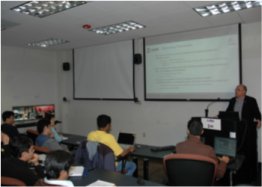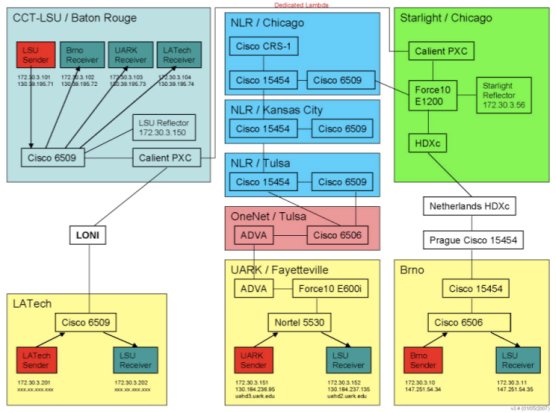Optical Multicast and High-Performance Digital Media

Website
http://www.icair.org/http://www.cct.lsu.edu/news/news/203/
Contact
Joe Mambretti, International Center for Advanced Internet Research (iCAIR), Northwestern University, United StatesCollaborators
Canada: NortelCzech Republic Masaryk University; CESNET
United States: Northwestern University; Louisiana State University; Louisiana Tech University; University of Arkansas; MCNC; Louisiana Optical Network Initiative (LONI); Arkansas Research and Education Optical Network (ARE-ON); National LambdaRail; StarLight
Description
Louisiana State University (LSU) Center for Computation and Technology (CCT) professor Thomas Sterling, a renowned researcher in the field of high-performance computing (HPC), is teaching a Spring 2007 semester class “High-Performance Computing: Concepts, Methods and Means”. It is the first course in the US being taught using high-definition (HD) video broadcast for distributed classroom instruction. The course is offered to students at LSU, Louisiana Tech University, University of Arkansas, MCNC in North Carolina, and Masaryk University in the Czech Republic.
The NSF IRNC-funded TransLight/StarLight optical network link between the US and Europe is currently used to transmit uncompressed HD video streams to the Czech Republic. Statewide research and education optical networks Louisiana Optical Network Initiative (LONI) and the Arkansas Research and Education Optical Network (ARE-ON), and the nationwide optical network National LambdaRail, help support the course to locations in the US. Virtual presence requires high-quality HD video and two-way audio transmission with minimum latency. A single raw HD stream consumes about 1.5 Gbps of bandwidth, and multi-site virtual meetings like this course can easily saturate a 10 Gbps link. This far exceeds the on-demand bandwidth available on the Internet, though course organizers are distributing the course via the Internet to Access Grids at select sites that do not yet have their optical connections and/or HD technologies in place.
In collaboration with Nortel, Northwestern University is working on a dynamic optical multicast technique for disseminating streams in lieu of the stream replication method currently used. The optical multicast equipment and the computers used for multicast replication are homed at StarLight.
Multicasting digital media using L1/L2 transport provides a number of significant benefits, including higher performance, enhanced management, cost effectiveness, quality of service, etc. Optical multicast allows for much larger streams than packet routed networks, e.g. multicast at multiple Gbps. In this context, high-performance refers to reliable, consistent, high-quality delivered service, with minimal jitter and latency over very long distances.


